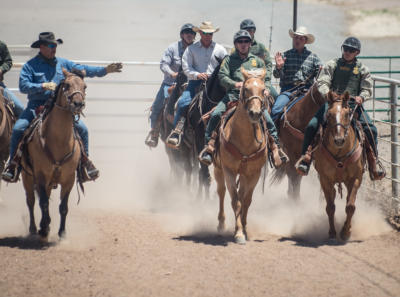
The four Border Patrol agents who made it through week one of horse patrol training trotted their charges around and around an arena under a hot sun, stirring dust clouds from the dirt track.
They, at least, could say they had made it this far: Six fellow agents had already dropped out.
The six-week horse patrol training course is considered among the most challenging the Border Patrol has to offer, and along New Mexico’s rural border, its graduates are among the most in demand.
The grueling training puts agents on horseback – many for the first time – eight hours a day, five days a week, for four weeks in an arena and two weeks in the field among the sharp-toothed mountain ranges of the Bootheel region.
Border Patrol agents are outfitted with top-notch equipment and technology, including long-range thermal-image cameras, ground sensors, trucks and SUVs specially outfitted with Kevlar tires and all-terrain vehicles.
But in the rugged, rural region that characterizes New Mexico’s Bootheel, many agents – and the ranchers who live out there – say old-fashioned horse patrol is just as indispensable.
“We spend most of our time in the mountains,” said Agent Gerald Hancock, who runs the horse patrol program at the Lordsburg station. “We go where no one wants to go.”
Border Patrol shifted about a dozen horses to the Lordsburg station in recent weeks to bring the stable to 30 quarter horses and mustangs.
The shift came after an outcry earlier this year by local ranchers over border security. One of their demands was to see more agents on horseback – considered a more effective and environmentally friendly manner of patrolling an area with sensitive ecosystems and few passable roads.
“We’re working on expanding the barn,” said Agent José Gardea, the Lordsburg station’s patrol agent in charge.
An “ideal” number of horses would be 40, he said. The terrain is so rough that the horses can’t be ridden day in and day out, nights, too; they must rest.
Meanwhile, Lordsburg has 30 certified riders, both men and women, and a waiting list of agents who want to train to ride, he said.
“A lot of guys who put in for this training have never been on a horse,” he said.
On training Day 8, when the Journal paid a visit to the class, four agents had their horses trot around the Lordsburg fairgrounds arena in unison, learning formations, reining and leg control.
“The first week is always the toughest,” said Agent Gilbert Molina, the lead trainer, from atop his caramel-colored horse, Buttercup. “That’s when they figure out if they want it. About 35 percent get through.”
Agent Cole Potts tied up his horse, Outlaw, as the training day wound down. He put in for horse patrol “mainly for the challenge,” he said.
“It takes physical fitness and mental grit to have the mindset, ‘I’m going to make it through this course,’ ” he said. “Everybody is hurting. You just drive through the pain.”
One more agent would drop out before the training ended. Just three agents – Potts, Dwayne Wilkinson and Gregory Webb – graduated horse patrol training last month.
